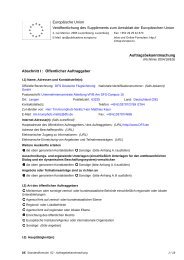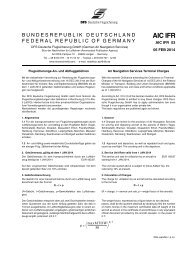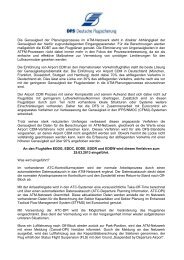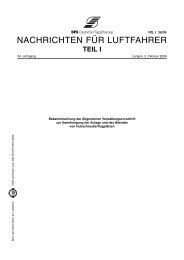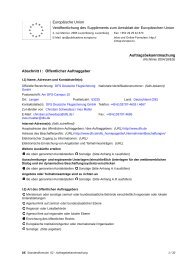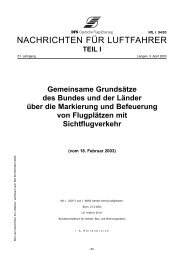TE im Fokus 02/2013 - DFS Deutsche Flugsicherung GmbH
TE im Fokus 02/2013 - DFS Deutsche Flugsicherung GmbH
TE im Fokus 02/2013 - DFS Deutsche Flugsicherung GmbH
Sie wollen auch ein ePaper? Erhöhen Sie die Reichweite Ihrer Titel.
YUMPU macht aus Druck-PDFs automatisch weboptimierte ePaper, die Google liebt.
Informationen aus dem Bereich Forschung und Entwicklung<br />
der <strong>DFS</strong> <strong>Deutsche</strong> <strong>Flugsicherung</strong> <strong>GmbH</strong><br />
for 3NM separation or a target report that is spurious<br />
i.e. does not relate to any target within the<br />
service coverage volume. According to ED-142<br />
[1], the probability of false detection (PFD) shall<br />
be less than or equal to 0.1%.<br />
The WAM false target analysis intended to identify<br />
firstly the nominal cases and secondly the different<br />
false target cases. The following symbols<br />
and terms are used for the description of the<br />
nominal and false target cases:<br />
• Detection Coverage Volume (DCV): Volume of<br />
airspace in which the surveillance system receives<br />
signals from targets.<br />
• Surveillance Coverage Volume (SCV): Volume<br />
of airspace for which the surveillance system<br />
provides target reports to surveillance data processing<br />
system (SDPS). Within the SCV the<br />
required performance criteria shall be fulfilled.<br />
The SCV must be a sub-volume of the detection<br />
coverage volume.<br />
• Symbols:<br />
Fig. 14: Type 2: large position deviation („jumps“)<br />
• Type 3: small position deviation („outlier“, also<br />
three cases distinguished, see Figure 15). As<br />
the difference in position deviation is smaller,<br />
another detection mechanism needs to be<br />
used. The analysis of cases and in Figure<br />
14 has to clarify if the corresponding false target<br />
reports could generate a false track. This is<br />
usually the case if more than three false target<br />
reports in a t<strong>im</strong>eframe of about 15 second exist<br />
having s<strong>im</strong>ilar orientation.<br />
A structured analysis about possible WAM false<br />
targets identified the following four cases (plus<br />
several sub-cases)<br />
• Type 1: not existing traffic (two cases distinguished,<br />
see Figure 13)<br />
Fig. 15: Type 3: small position deviation („outlier“)<br />
Fig. 13: Type 1: not existing traffic<br />
• Type 2: large position deviation („jumps“, three<br />
cases distinguished, see Figure 14)<br />
• Type 4: Split Tracks (see Figure 16). This case<br />
identifies a situation where the WAM system<br />
has established a track for a certain target (e.g.<br />
as Mode S target) and establishes another<br />
track (using a different track number) for the<br />
same target as Mode 3A/C target. Usually<br />
these split tracks have no significant position<br />
deviation (horizontal and vertical) between original<br />
and split track. In most cases, the Mode 3A<br />
code is s<strong>im</strong>ilar for both tracks.<br />
Fig. 16: Type 4: split tracks<br />
Data Performance Analysis of WAM Systems<br />
Ausgabe 2/<strong>2013</strong> Seite 12



